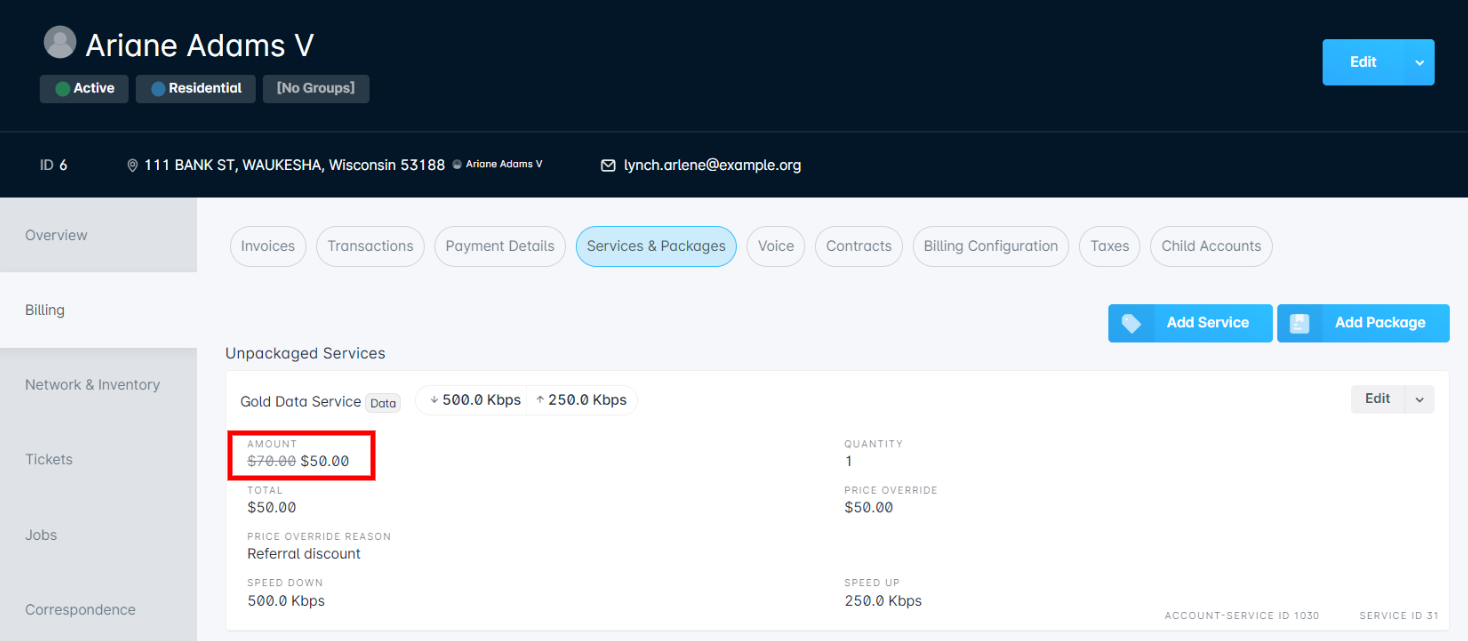Our Products & Services
Getting Started
First Time Setup
Getting Started With Jobs
Getting Started with Accounts
Getting Started with Inventory
Getting Started with Ticketing
Setting Sonar up for Billing
Baseline Configuration
How To: Using Sonar's Customer Portal
User Specific Resources
Accounts
Account Groups: Overview & Example Use Cases
Account List View: Overview
Account Management View: Overview
Account Overview Customization
Account Statuses: Overview & Example Use Cases
Account Types: Overview & Example Use Cases
Anchor & Linked Serviceable Addresses: Overview and Best Practices
Archiving an Account: Overview
CPUC Fixed Broadband Deployment by Address
Child Accounts: Best Practices & How Tos
Creating a New Account
Direct Messages: Overview
Disconnecting an Account
Disconnection Reason Management: Overview
Exploring Task Groups
FCC Broadband Data Collection (BDC) Filings: How Sonar Can Help
FCC Data Exports: General Overview and Usage
Future Serviceable Addresses: Overview
Lead Intake Form Processing
Notes: Best Practices & Use Cases
Scheduled Events: Overview & Use Cases
Serviceable Addresses: Overview and Usage
Specify Account ID upon Creation
Tasks & Task Templates: Overview
Using Sonar's FCC Broadband Label Generation Tool
Billing
ACH Batching: Overview
Accounts in Vacation Mode
Avalara: Overview & Setup
Batch Payments & Deposit Slips: Overview
Billing Calculator
Billing Defaults
Billing Settings
Building Packages
Building a Data Service
Canadian ACH tool
Changing Service Pricing in Sonar: Best Practices
Considerations When Using Avalara with Voice Services
Creating Discounts for Services and Packages
Delinquency Billing Best Practices
Delinquency Exclusions: Overview and Use Cases
Dual Data Services: Overview
Email Invoice Batch: Overview
General Ledger Codes: Overview
General Transactions: Best Practices
How Sonar Prorates Billing
How to Take Bank Account Payments
How to: Adding a Service to an Account
Invoice Templates: Overview
Leveraging PayPal as a Payment Method in Sonar
Manual Transactions
Multi-Month Billing & Multi-Month Services
Print to Mail
Printed Invoice Batches: Overview
Services: Overview
Setting Up Payment Methods and Taking Payments
Setting up Bank Account & Credit Card Processors
Taxes Setup
Usage Based Billing Policies: Overview and Usage
Usage Based Billing Policy Free Periods: Overview and Usage
Using Tax Exemptions - How To
Communication
Communications: Call Logs Overview & Best Practices
Communications: Messages Overview
Email Variables & Conditions
Message Categories: Overview & Use Cases
Phone Number Types: Overview and Use Cases
Saved Messages: Overview
Setting up an Outbound Email Domain
Trigger Explanations
Triggered Messages: Setup
Using Outbound SMS
Using the Mass Message Tool
Companies
How to: Setting Up a Company in Sonar
Managing Multiple Companies in Sonar: Best Practices
Rebranding your Sonar Instance
Financial
Contract Templates
Invoice Attachment Use Cases & PDF Examples
Invoice Messages: Overview & Use Cases
Invoices in Sonar: Examples, Creation & Contents
Integrations
Atlas Digital CORE Integration
Calix Cloud Data Field Mappings
Calix SMx Integration: Overview
CrowdFiber Integration
External Marketing Providers
GPS Tracking Providers: Overview
GoCardless Integration: Overview & Setup
How to Connect Cambium to your Sonar Instance
How to Connect Preseem to your Sonar System
How to: Using Webhooks in Sonar
Integrating with Calix Cloud
RemoteWinBox - Integration with Sonar
Sonar Retain: AI-Powered Customer Retention & Quality Intelligence
The Sonar Field Tech App
Tower Coverage Integration: Overview
VETRO FiberMap V2 Integration: Overview
VETRO FiberMap V3 Integration: Overview
Webhooks in Sonar: Basic PHP Example
iCalendar Integration
Inventory
Inventory List View: Overview
Inventory Model Management: General Overview
Network Inventory: How-to & Usage Guide
Segmentable Inventory: How-to & Usage Guide
Setup of Inventory: Manufacturers, Categories, and Assignees
Tracking and Using Consumable Inventory
Jobs
Applying Task Templates to Jobs
Edit Job Options
Example Jobs & Templates
Geofences: Overview
Job Types: Best Practices
Jobs and Scheduling: Overview
Scheduling How-to: Creating and Booking a Job
Scheduling Week View: Overview
Setting Up Schedules General Overview
Mapping
Misc.
Combining Custom Fields & Task Templates for Information Storage
Custom Fields Overview & Use Cases
Custom Links: Overview
Task Templates Overview & Use Cases
Monitoring
Building Alerting Rotations
Building a Monitoring Template
Poller Troubleshooting
Pollers: General Overview, Deployment Strategy, Build Out & Setup
Networking
Adtran Mosaic Cloud Platform Integration: Overview
Assigning RADIUS Addresses
Assigning an IP Address Using Sonar's IPAM: How to
Automating IP Assignments, Data Rates, and Network Access in Sonar
Building Address Lists
Building RADIUS Groups
Building a Device Mapper
Cable Modem Provisioning
Controlling Customer Speeds with Sonar: General Overview
DHCP Delivery
Data Usage Available Methods
Finding your OIDs
FreeRADIUS 3: Build-Out & Integration
How Sonar Communicates - Egress IPs Explained
IP Assignments & Sonar
IPAM: Basic Setup
IPAM: Overview
LTE Integration
MikroTik as an Inline Device: Integration With Sonar
MikroTik: Controlling Access
MikroTik: Controlling Speeds
MikroTik: Setting Up a Sonar Controlled DHCP Server
Netflow On-Premise Integration: Setup and Overview
Network Dashboard: Overview
Network Sites: Management View Overview
PacketLogic: Integration With Sonar
Pulse, Polling, and PHP
RADIUS: Build-Out & Integration with Sonar
RADIUS: Building Reply Attributes
Setting Up CoA Proxy
Sonar Flow
Sonar IP Addressing
Using Multiple Network Devices in Sonar
Purchase Orders
Release Notes
Reporting
Enhanced Business Intelligence - Tips & Tricks for Advanced Users
How To Enhance Your Reporting With Custom Field Data
Report Licenses
Sonar's Business Intelligence: Overview
Understanding Sonar Reports
Using Sonar DataConnect to Connect BI Applications with Your Sonar Instance
Security
Application Firewall: General Overview and Best Practices
Auth0: Overview
Multi-Factor Authentication: Overview
Password Policy In Depth
Removing a Terminated Employee In Sonar
Role Creation using GraphiQL
User Role Creation & Best Practices
Users: Overview
Sonar Billing
sonarPay
sonarPay Canada Disbursements: Overview
sonarPay Chargebacks & Disputes: Overview
sonarPay Disbursements: Overview
sonarPay Monthly Statement: Overview
sonarPay Overview
sonarPay Reversals, Voids, & Refunds: Overview
sonarPay: Token Migration Process
System
A Deeper Dive into the New Sonar API
API Calls Using Third Party Applications: Personal Access Tokens
Browser Compatibility and Minimum Hardware Requirements for Sonar
Consuming the Sonar API
Controlling Your Landing Page: Personal Preferences
Customizing Your Customer Portal
Date/Time Picker: Overview
Dynamic Time Zones in Sonar
Filtering: Overview
Frequently Used Terms
Getting Your Data into Sonar
GraphQL Rate Limiting Overview
How To Use GraphiQL to Understand the Sonar API
How Your Data is Backed Up
How to Best Use Global Search
Interacting with Files via the API
Introducing the New Sidebar
Main Menu: Overview
Mutations in the Sonar API
Notification Preferences
REST API Wrappers for V1 Compatibility
SMS Notifications
Sonar's Rich Text Editor
System Settings: Overview
The New Sonar API
Troubleshooting the Customer Portal
Upgrading your Ubuntu OS - Customer Portal Upgrades
User Profile: Your Personal User Settings
Ticketing
Advanced Ticketing Features
Canned Replies Examples & Templates
Canned Reply Categories
Exploring Ticket Groups
How Sonar Manages Spam Tickets
How to Integrate Inbound Mailboxes with Slack
Inbound Mailboxes Example Build
Ticket Category Families & Ticket Categories: Overview
Ticket Resolution Reasons: Overview
Ticketing: Overview
Using Parent Tickets
Voice
API Changes for Voice Billing
Best Practices to Remain CPNI Compliant
Billing Voice Services in Sonar
Deploying Voice Services in Sonar
Working With the Sonar Team & Additional Resources
Sonar's Security Practices & Certifications
Sonar and General Data Protection Regulation (GDPR)
Sonar's Security Strategies
Technical Security Overview
Best Practices for Fast Tracking a Support Request
Feedback Portal / Suggest a Feature
Learning with Sonar: Tools and Resources
New Client Training Overview
Sonar Casts Table of Contents
Submitting Bugs vs. Feature Requests
The Sonar Community Forum
The Sonar Status Page
Third Party Customer Support Referrals
Table of Contents
- All Categories
- Billing
- How to: Adding a Service to an Account
How to: Adding a Service to an Account
 Updated
by Mitchell Ivany
Updated
by Mitchell Ivany
Read Time: 5 mins
Adding a Service to an account actively lets you charge and invoice customers within Sonar. Whether you're adding recurring services or sets of One-Time transactions, almost all billable activity relies on Services.
Before adding Services to an account, there are a few prerequisite pieces to the puzzle. First, you'll need to have Services created, which is detailed within the Services: Overview article. Next, you'll need to have accounts created, which is covered in the Creating a New Account article.
Adding the Services
Adding Services is a straightforward process, simply follow these steps:
- Access the Accounts Page, then click on the name of the account:
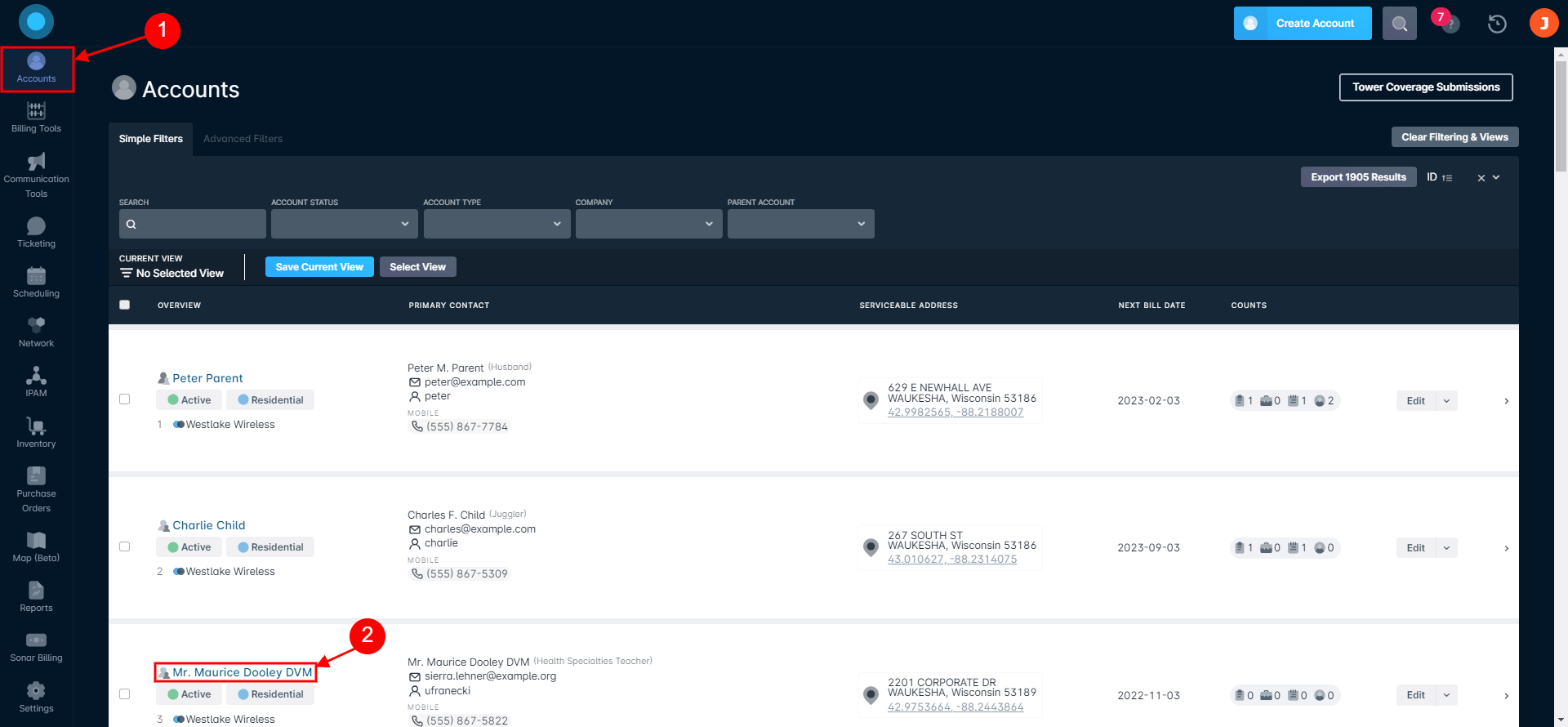
Accessing the Account Through the Search Bar
You can also open an account by using the Global Search tool, accessible at the top of every page, or by double-tapping the SHIFT key. Once open, type in the Account Name or Account ID and click the Globe Icon: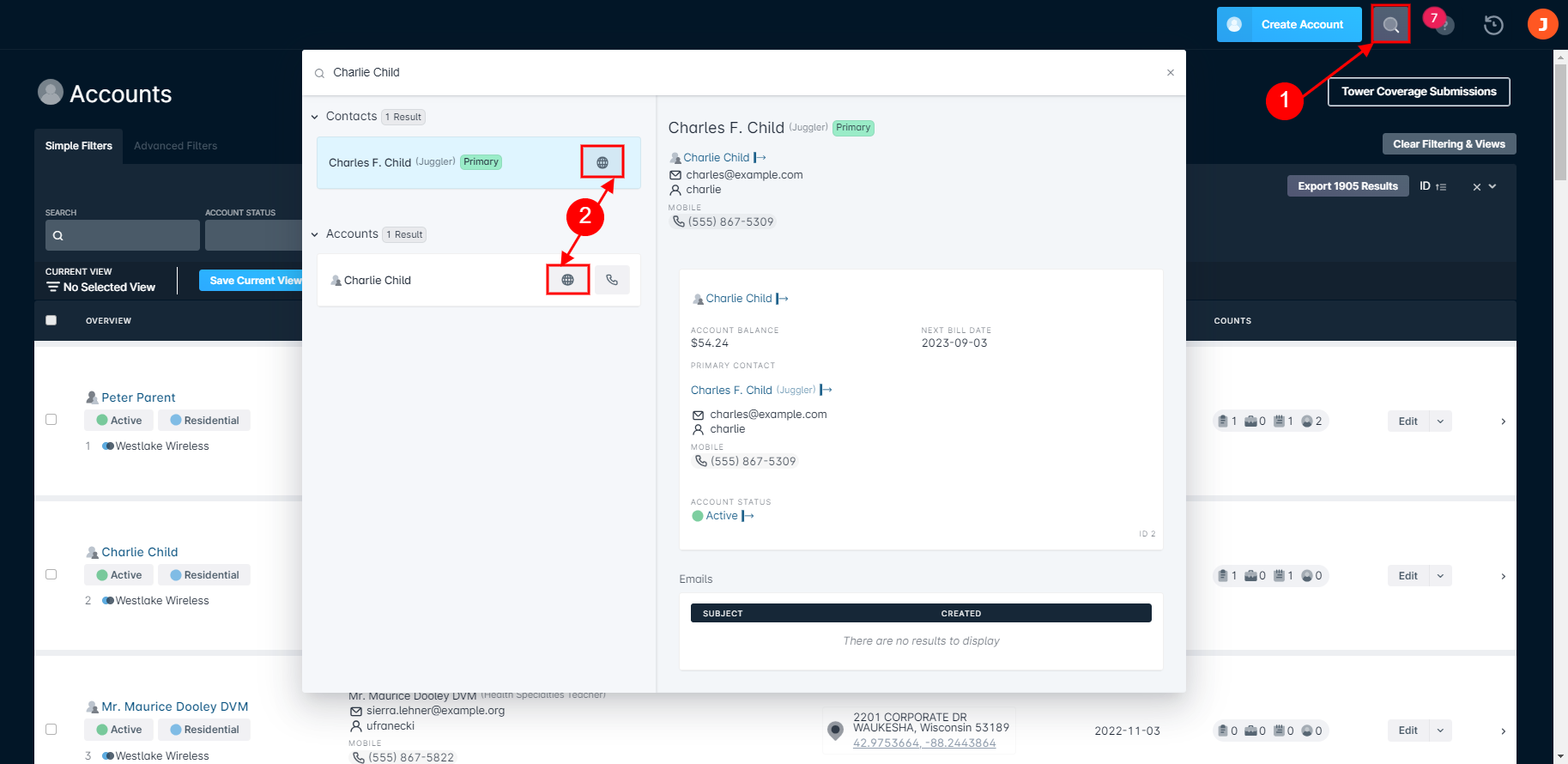
- This will bring you to the Account Management View. From there, click on the Billing Tab, then the "Services & Packages" sub-tab:

- If there are any Services already on the account, they'll be displayed here. Using either the centrally located "Add Service" button, which only appears if there are no services on the account, or the button in the top-left, we can open the Create Account Service modal:

- With the modal open, select your service from the dropdown and fill in all required fields:
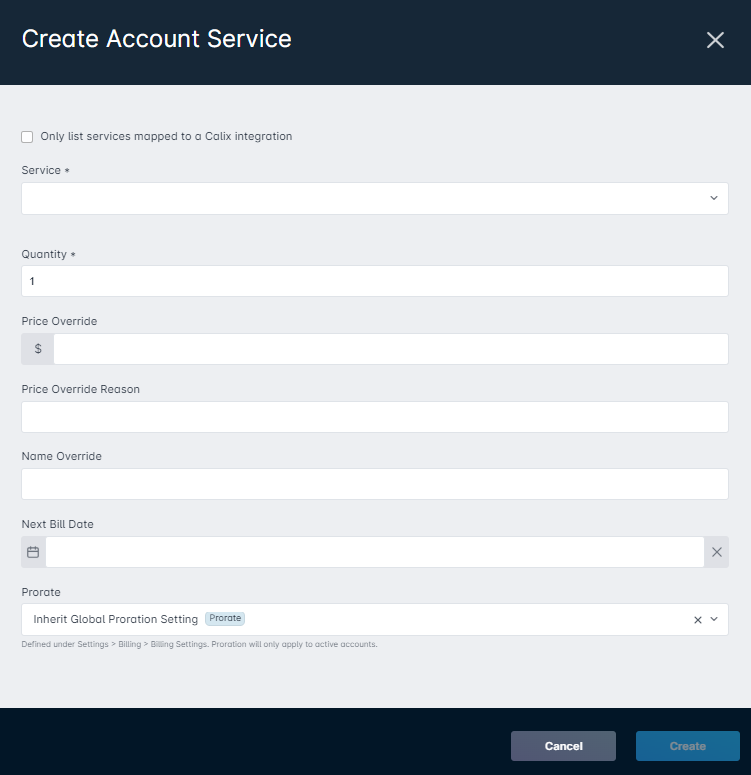
Account Service Fields Breakdown
Create Service Modal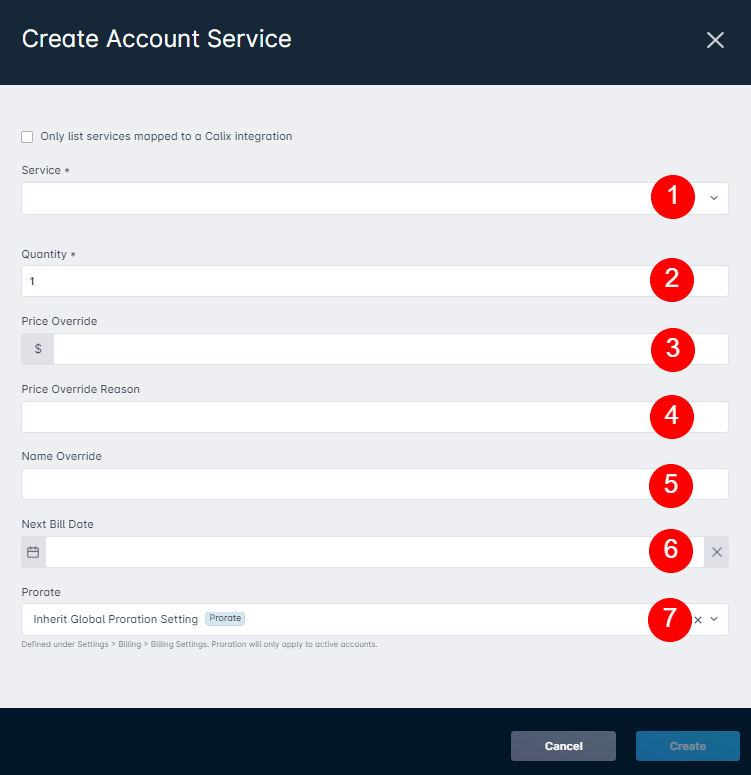
1. The Service Dropdown will allow you to select context-appropriate services, in this case, it will display Data Services, Expiring Services, Recurring Services, and Voice Services.
2. The Quantity field allows you to add multiple of the same service to the account. This is useful for some recurring services, such as Domain Renewals.
3. The Price Override allows you to set a custom price for the Service being added to the account. This override will persist for the account, regardless of any changes made to the original service price.
4. The Price Override Reason field allows you to include notes on why the price is being overridden. This field will appear regardless of if a Price Override is provided, but it is not a required field.
5. The Name Override field allows you to provide a unique name for this service, which will appear on invoices and on the transactions list.
6. The Next Bill Date field will be available when setting multi-month services to accounts that bill monthly, allowing you to specify the next bill date for the service.
7. The Prorate field allow you to adjust the cost of the service when it's added to the account, based on the progress through the Billing Period. - Once you click "Create", the Service will be applied to the account:
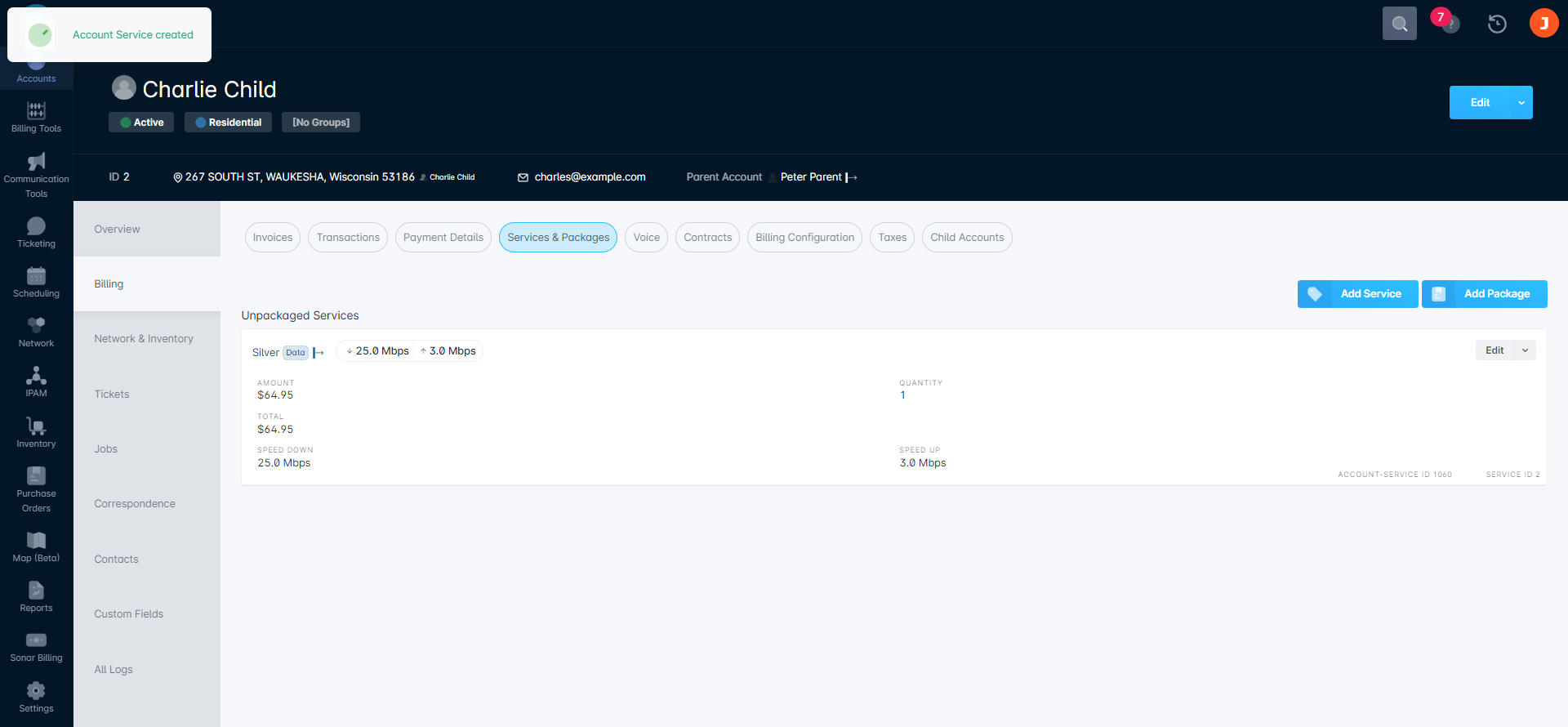
Services added in this way are billed and invoiced on a monthly basis, in line with the configuration of the account's billing settings.
One-Time & Adjustment Services
While the previous section demonstrated how you can add any Data, Expiring, Recurring, or Voice services to an account, this section will provide examples of adding One-Time Services/Transactions, and show where Adjustment Services would be added.
From any account management view, follow the below steps:
- Click on the Billing tab, followed by the "Transactions" sub-tab:
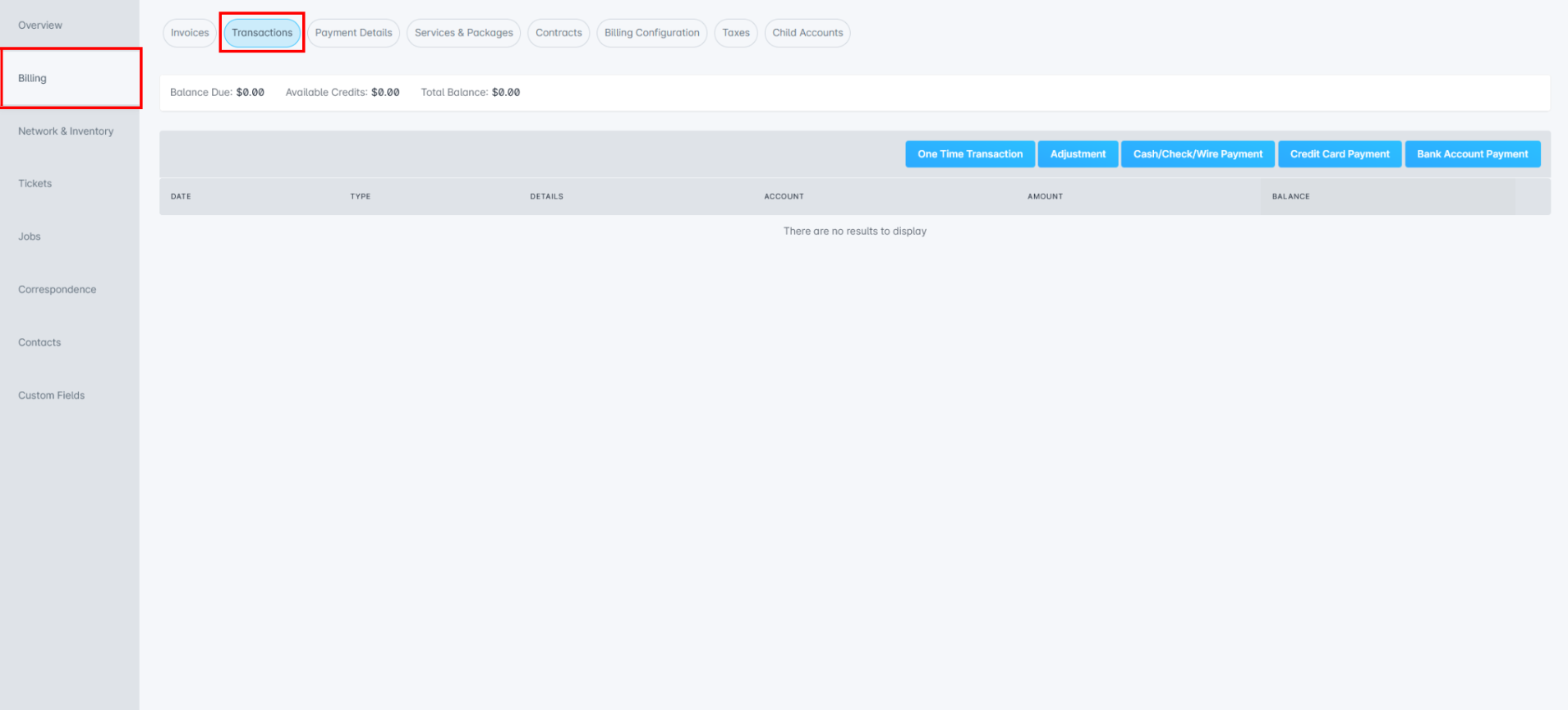
- Using the highlighted buttons, you'll be able to manage your One-Time Transactions or Adjustments.
- The One-Time Transactions menu allows you to add any service available to this account, limited by Account Group, Account Type, or the Company, to the account. This is the only way you're able to add One Time services created in your instance.

- The Adjustment menu allows you to make use of the created Adjustment Services in your instance. Using Adjustments will contribute towards any caps or limitations you've set when creating the Service.

- The One-Time Transactions menu allows you to add any service available to this account, limited by Account Group, Account Type, or the Company, to the account. This is the only way you're able to add One Time services created in your instance.
Services added as an Adjustment or One-time transaction will be billed immediately, but invoiced in line with the account's billing settings.
Overage Services
The last type of service that can be added to a customer account is an Overage service.
Overage Services get applied in two ways:
- Automatically, as part of the Usage Based Billing policy, when the customer surpasses the allocated usage.
- Manually, as part of a Data Top OffData Usage Top-Offs can only be added if the "Allow purchase of additional capacity during billing period" option is enabled during Usage Based Billing Policy creation:
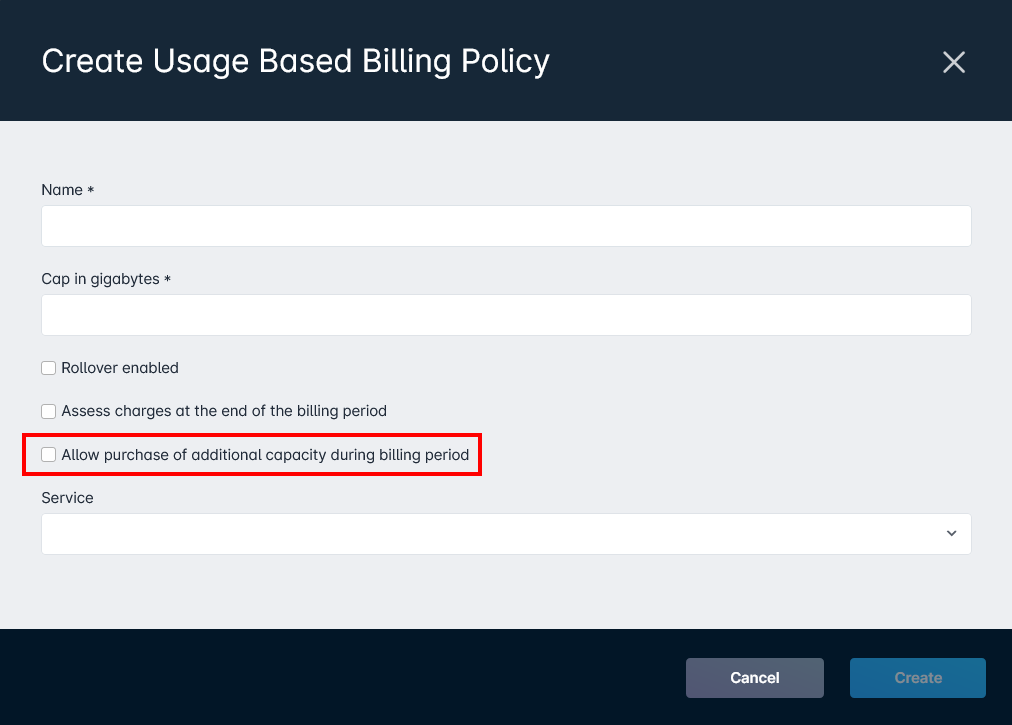
- From any Account Management View, as long as the Account's service has a Usage Based Billing policy enabled, go to the Billing Tab, then the Transactions sub-tab:

- Using the "Data Top Off" button located above the Transactions pane, we can apply one or multiple instances of the Overage Service:

- Highlighted, you can see which Overage service is being used, dependent on the Usage Based Billing Policy:

- From any Account Management View, as long as the Account's service has a Usage Based Billing policy enabled, go to the Billing Tab, then the Transactions sub-tab:
Data Usage Top-Offs will be billed immediately, but will only be invoiced in line with the account's billing settings.
Price Overrides on an Account
When adding a service to an account, or when editing it at a later date, it's possible to apply a price override to the service. Price overrides are used to change the amount being charged for a service at the account level. When a price override is applied to a service, details about the override and the original price will be viewable on the account, as can be seen in the image below.
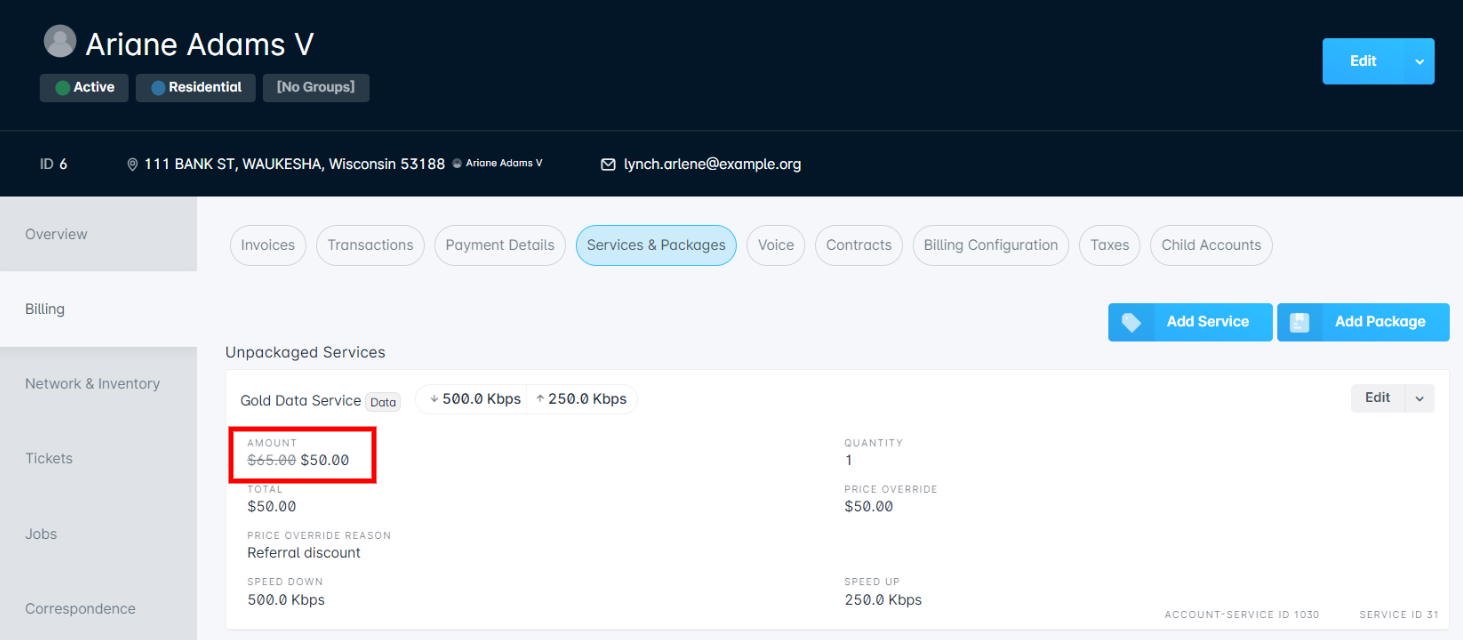
When a price override is in place, that price will persist at the account level regardless of any changes made to the original amount for the service. For example, in the image above we can see the original price of the service is $65, with our override set to $50 for the customer. If we increased the original price of the service to $70.00, the customer would continue to be billed for the $50.00, as set in the price override on the account; however, this change in the original service pricing would now be updated at the account level, as seen in the image below.
